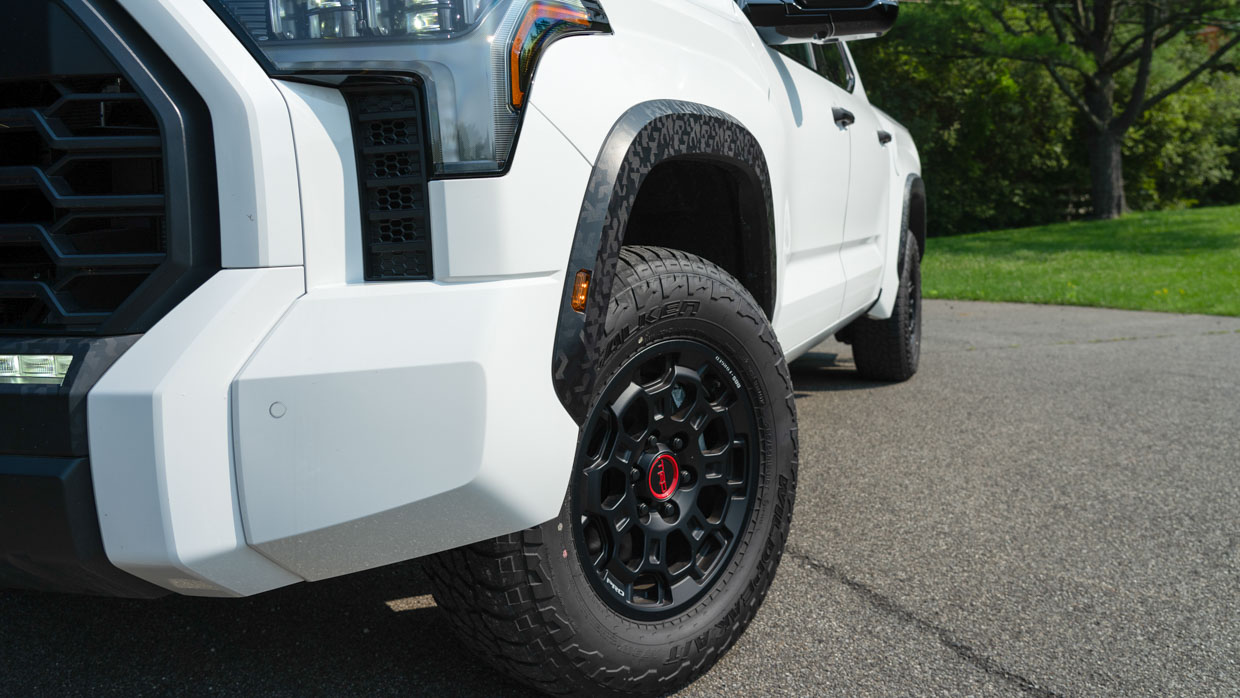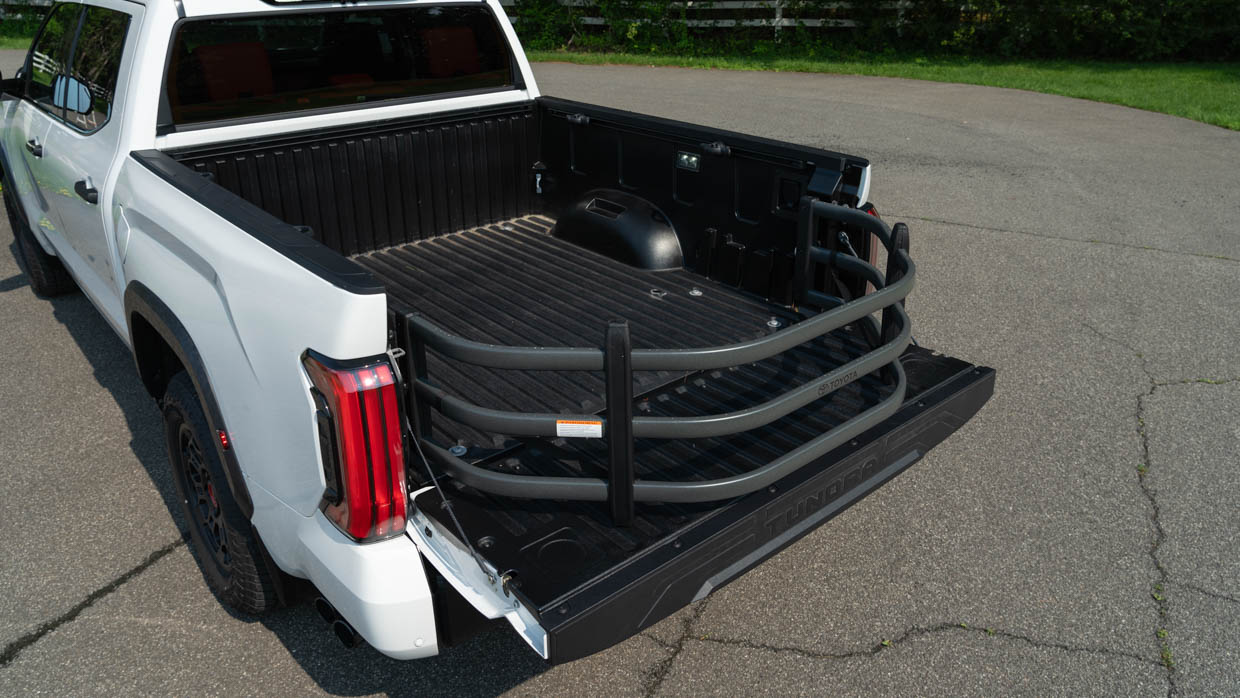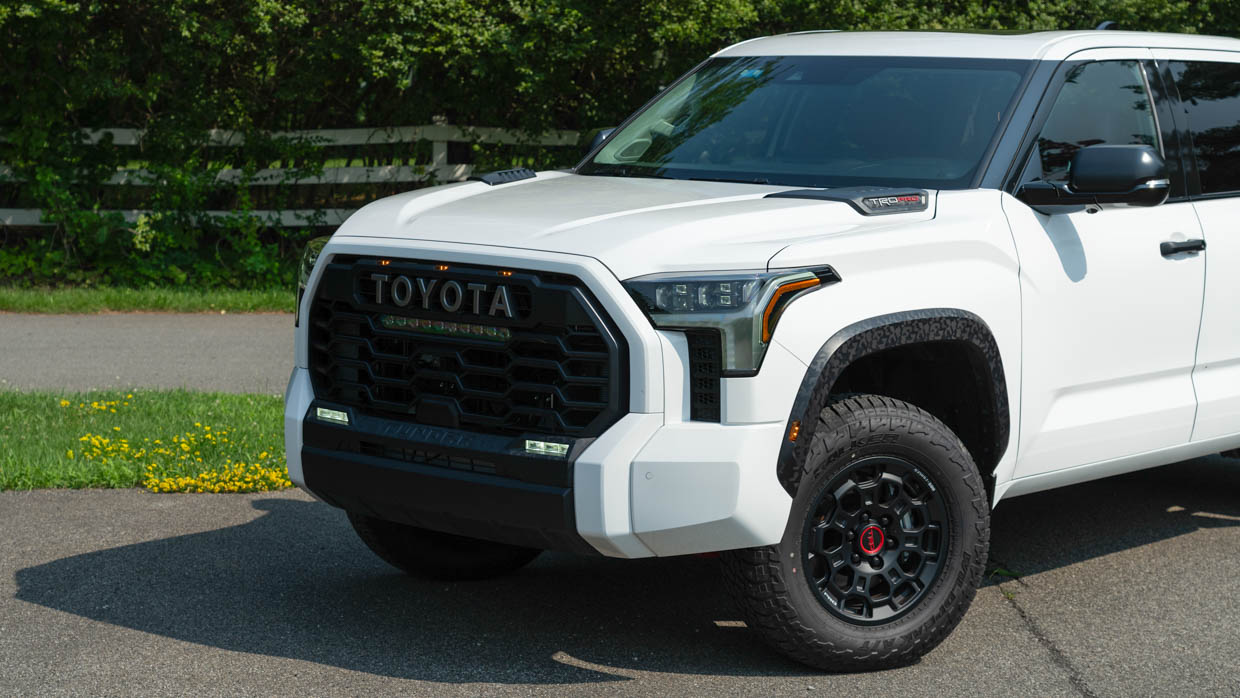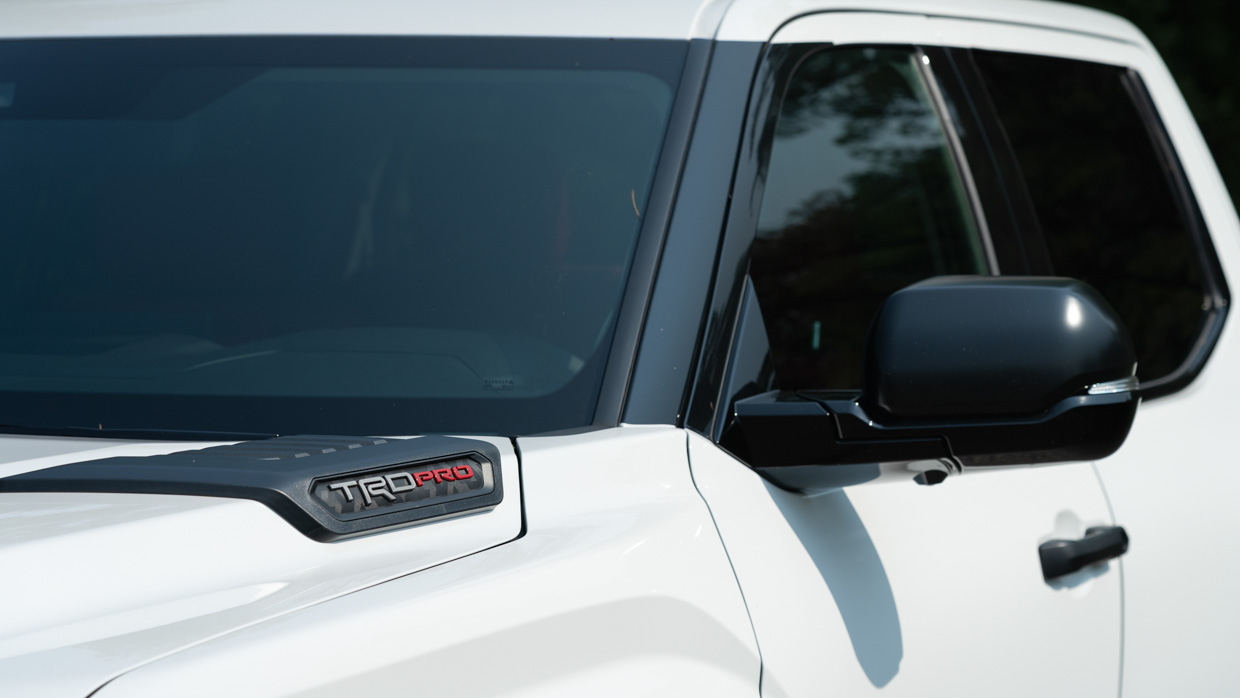-
Car Reviews
- Car News
-
Car Comparisons
Latest comparisons
- Chasing Deals
We head Stateside to drive the hardcore TRD Pro variant of the Toyota Tundra pick-up before it lands in Australia in 2024
If you’re a ute, or a pick-up truck in American parlance, you just can’t turn heads at dealers these days unless you’re wearing off-roady plastic cladding and an intimidating set of lights.
Call the addenda a coat of curious war paint for machines that will spend only some of their time shuttling cargo – and much of it hauling nothing at all. Like in Australia, here in the US, very expensive pick-ups don’t see all that much time off-road.

But a rugged look counts for much, and it’s for surely that reason that the Toyota Tundra received an aggressive glow-up for its current generation.
You can get a chromed-up posh model in the Tundra Capstone – likely the first to land in Australia when the Hilux’s big brother goes on sale in 2024 – but for anyone who thought that the Capstone wasn’t enough, there’s the ultra-aggro TRD Pro you see here.
Despite the Fox-brand suspension on all four corners and a belly full of skid plates below, the Tundra’s practical, comfortable, utilitarian formula still shines through.

When we drove the 2024 Tundra TRD Pro, we had three questions in mind.
Even in off-road spec, does Toyota’s biggest, flashiest truck have what it takes to compete?
With Toyota Australia looking into right-hand drive conversions, is the Tundra worth getting excited about?
And should Toyota Australia sell the TRD Pro variant of the Tundra in Australia?

In the United States, Toyota offers a dizzying array of trims, sizes, engines, and options packages that will ensure anyone looking to put one of these big boys in their driveway will need to bring a spreadsheet or two along to the dealership.
First up come the trim levels, of which there are seven:
The Tundra has three different bed lengths, the shortest being 5.5 feet (1.7 meters), then stepping up to 6.5 feet (2.0 meters), and going all the way up to 8.1 feet (2.5 meters) for those who frequently carry cargo and rarely make U-turns.
Two different cab configurations are available, Double Cab and Crew Max, the latter of which offers a preposterous amount of rear-seat legroom. Both are four-doors.

Finally comes the drivetrain options. Every Tundra has a 3.5-liter twin-turbocharged V6, which Toyota calls its iForce motor with dual overhead cams and variable valve timing. That engine makes 290kW of power and 649Nm of torque.
For a little more shove, you can step up to the iForce Max, which adds on a hybrid system with a 1.87kWh battery pack.
The hybrid model’s fuel economy does drop a bit, but this is really about the performance, 326kW and 790Nm to be exact – way beyond what you’ll get in any Hilux.
Regardless which engine you choose, power runs through a smooth-shifting 10-speed automatic that’s new to the Tundra, directed to either the rear wheels or all four with the optional 4×4 setup.

Add the TRD Off-Road package onto the Tundra and you also get an electronic locking rear differential, plus a host of traction-focused drivetrain control modes.
The TRD Pro, of course, comes with all that standard and lots more, including a custom suspension tune with Fox dampers and an upgraded, 12-speaker JBL sound system paired with a 14-inch touchscreen.
The TRD Pro you see here with a few options stickered at US$72,204, or AU$106,140.
The Tundra is, without a doubt, a big truck. In TRD Pro trim, with the Crew Max cab and 1.7-meter bed, this thing is 5.9 meters long, just a hair over 2.0 meters wide, and just under 2.0 meters tall.
That makes this Tundra 61cm longer than a Hilux, 18cm wider, and 11cm taller. The TRD Pro badging on the fenders stands at chest level with even tall adults, and most will need to rise up on their toes to get a good look in the engine bay.

There’s a lot going on in there, so it’s worth taking a look. Toyota’s iForce Max is a big V6 with a big hybrid system to boot, again offering a total output of 326kW and 790Nm.
As in Toyota’s other iForce Max applications, like the equally giant Sequoia 4WD wagon – effectively the wagon version of the Tundra – the goal with the hybrid system isn’t so much fuel economy as it is providing quicker throttle response while the turbo works its way up to an indicated 20 psi of boost pressure.
The overall numbers are good, enabling the TRD Pro to tow 5000kg in US format or to carry a payload of 728kg. The short bed, 1.7 m long, limits your hauling capability to some degree, but the optional, integrated flip-out extender here makes up for some of that.

That power goes to the ground through a rugged drivetrain with enough options and modes to get you through most conditions. The transfer case offers 2H, 4H, and 4L modes, while the rear differential can be manually locked when grip is especially challenging.
For a little extra help, the TRD Pro offers five so-called Multi-Terrain Select modes: Deep Snow, Mud, Sand, Dirt, and Auto, all accessed through a little knob just aft of the shifter.
That knob also toggles through the Tundra’s driving modes, which number just three: Sport, Normal, and Eco. These seem to really just change the throttle mapping of the Tundra, and in Sport it is reasonably sporty.

There’s still a good bit of lag between your foot going to the floor and the truck leaping forward, kick of the hybrid system coming after a moment, followed quickly by the surge of torque as the engine gets up to boost.
But that surge is strong. The truck has a reasonably good engine note to go along with it, though there seems to be a fair bit of digital augmentation going on.
You sit up high in the Tundra, no surprise given its dimensions, with good visibility to the sides and rear, but not so much out the windshield. The tall, angular hood makes seeing what’s immediately in front of the truck a challenge.
This should be a little bit worrying for anyone who doesn’t like unintentionally running over things. Thankfully, toggling on the 360 camera is just a quick button press away.

On the go, the Tundra is pleasant enough to drive. Again, the throttle response is a bit tame but the outright performance is good, while consumption of as little as 11.76L/100km is respectable given the physics at play here.
The Tundra’s steering is predictably slow but overall ride quality is extremely good. Yes, it crashes over bigger bumps and takes a moment to settle itself again, but smaller asphalt imperfections and light off-roading are handled without fuss.
It is a respectably comfortable way to get to work and back, which is sadly what most of these trucks will do most of the time.
Climb on up into the Tundra, a process made somewhat challenging by the lack of running boards in the truck we tested, and you’re greeted with a searing sea of red leather, and plenty of embossed rubber trying to pass as the real thing.
The interior aesthetic is certainly sharp, especially the geometric patterns hiding behind the ventilated leather on the seats, aping the same patterns embossed on the truck’s fenders.

Seating is commodious, front or rear. There’s plenty of room in the back for three adults to sit shoulder-to-shoulder. They’ll have to fight over just two USB ports, one -A and one -C, but a 120V outlet means the third person won’t be totally left out to dry.
The two seats up front are heated and cooled and separated by a giant center console that offers Qi wireless smartphone charging, two more USB ports, and a gun safe. Yes, this is a truck very definitely targeting the US market.


Drive mode controls sit behind the chunky, leather-wrapped shifter and more big toggles are found up the center of the dash, handling things like traction control, trailer reverse assist mode, and all the HVAC settings.
There’s another USB port hiding just beneath the 14-inch touchscreen. The display is generously sized and offers both wireless Android Auto and Apple CarPlay.


Toyota’s current infotainment experience is basic but very usable and, most importantly, quite responsive when toggling between nav and media, for example, or scrolling through the long list of options.
That media is driven through a 12-speaker JBL sound system that offers the expected massive amounts of bass but also has a surprising amount of depth to the experience. Whether you’re into metal or classical, or even classical metal, this system can easily keep up.
The Tundra offers eight total airbags in the cabin, including knee, side, and curtain airbags for both driver and passenger.
When it comes to crash test ratings, since the Tundra isn’t available outside of the US just yet, we don’t have NCAP ratings to report.

What we do have are the US IIHS ratings, where the Tundra scored a “Good” rating across the board, “Good” being the top possible rating in every test, with the exception of two, scoring “average” when it came to lower leg injuries.
Though a hybrid, the Tundra TRD Pro is only frugal in relative, big truck terms. EPA-rated fuel economy in the US is 18 mpg city, 20 highway, and 19 combined.
That works out to fuel economy of 13.1L/100km in urban areas, 11.8L/100km on the highway and a combined score of 12.4L/100km.

In my real-world US testing I scored 17.1mpg, or 13.8L/100km. Overall, that’s maybe 3-4L/100km worse than a Toyota Hilux 2.8-litre diesel in similar conditions.
In the U.S., the Tundra comes with a five year/60,000 mile (97,000km powertrain warranty, which just about gets you just to 100,000 kilometers, and a 36-month, 36,000-mile basic warranty, which is just shy of 58,000 kilometers.
It’s interesting to compare how far ahead Toyota Australia’s five year/unlimited kilometre vehicle warranty is.

Go with the iForce Max engine and you get another warranty: 96 months or 100,000 miles on the hybrid system. That’s over 160,000 kilometers of protection.
The Tundra has 5000 mile, or about 8000 km service intervals, with every other one calling for an oil change.
Toyota’s new Tundra is a great truck forced to get big and look mean to stay relevant in an increasingly obese American truck market.
But, ignore the garish looks and the imposing dimensions and you have an honest, comfortable, and practical truck that can haul anything from kids to heavy equipment without complaint, either from the little ones or the truck itself.

The extra suspension bits and visual flare on the TRD Pro won’t be for anyone, but the good news is that none of it compromises the Tundra’s otherwise well-rounded manners.
Whether that visual attitude fits in your lifestyle, and whether Toyota Australia ever decides to bring it Down Under remains to be seen, but for anyone looking to step out of the predictable options from Ford, Chevy, and Ram, the Tundra is an excellent choice.
About Chasing cars
Chasing Cars reviews are 100% independent.
Because we are powered by Budget Direct Insurance, we don’t receive advertising or sales revenue from car manufacturers.
We’re truly independent – giving you Australia’s best car reviews.
The estimate provided does not take into account your personal circumstances but is intended to give a general indication of the cost of insurance, in order to obtain a complete quote, please visit www.budgetdirect.com.au. Estimate includes 15%^ online discount.
^Conditions Apply
Budget Direct Insurance arranged by Auto & General Services Pty Ltd ACN 003 617 909(AGS) AFSL 241 411, for and on behalf of the insurer, Auto & General Insurance Company Limited(ABN 42 111 586 353, AFSL 285 571).Because we don’t know your financial needs, we can’t advise you if this insurance will suit you. You should consider your needs and the Product Disclosure Statement before making a decision to buy insurance. Terms and conditions apply.
Indicative quote based on assumptions including postcode , 40 year old male with no offences, licence suspensions or claims in the last 5 years, a NCD Rating 1 and no younger drivers listed. White car, driven up to 10,000kms a year, unfinanced, with no modifications, factory options and/or non-standard accessories, private use only and garaged at night.
^Online Discounts Terms & Conditions
1. Discounts apply to the premium paid for a new Budget Direct Gold Comprehensive Car Insurance, Third Party Property Only or Third Party Property, Fire & Theft Insurance policy initiated online on or after 29 March 2017. Discounts do not apply to optional Roadside Assistance.
2. Discounts do not apply to any renewal offer of insurance.
3. Discounts only apply to the insurance portion of the premium. Discounts are applied before government charges, taxes, levies and fees, including instalment processing fees (as applicable). The full extent of discounts may therefore be impacted.
4. We reserve the right to change the offer without notice.